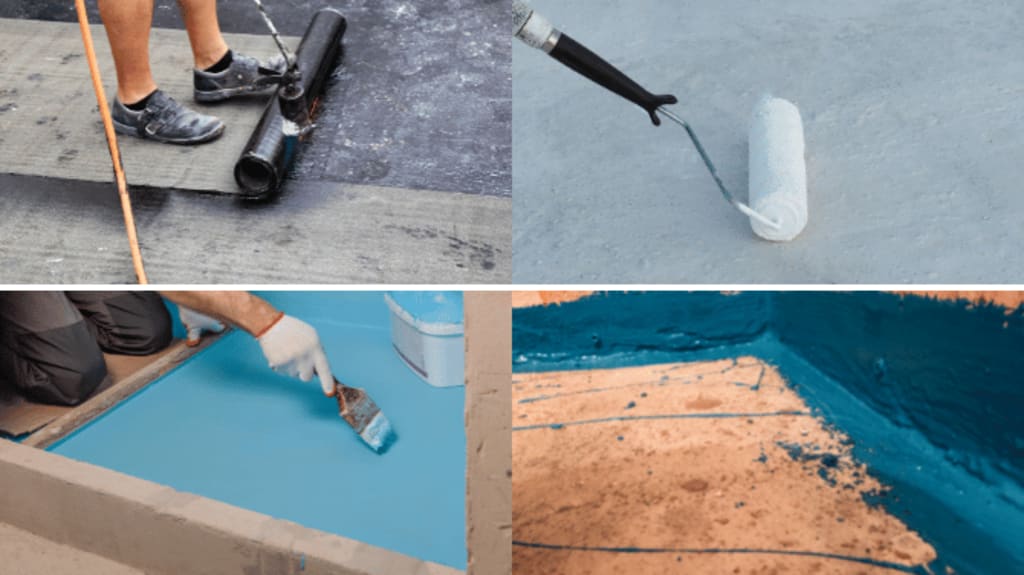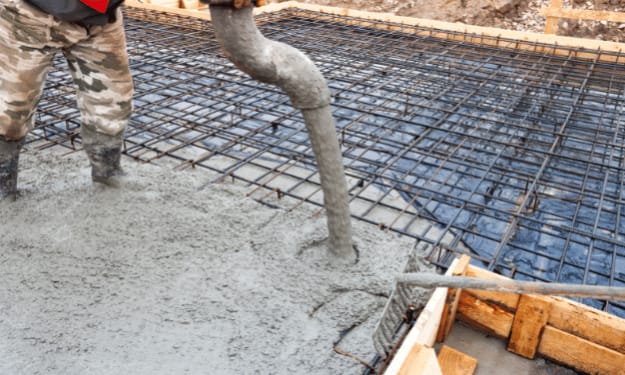What are the Waterproofing Materials?: All Types, Uses, and Features
Redwop Chemicals

One of the most important applications in construction is waterproofing. Waterproofing improves the durability of many different surfaces in construction. In addition, waterproofing materials should be applied in order to ensure the comfort of the house or office to be used after the construction is finished. So, what are the most ideal waterproofing materials? Which waterproofing material should be used for which part of a house? You can find answers to these questions in our article.
What is Water Insulation?
Before we find an answer to the question of what are waterproofing materials, we need to ask ourselves the meaning of water insulation.
Waterproofing is the process of making an object or structure waterproof or water-resistant. Thanks to this process, the insulating material or structure remains unaffected by water or resists water ingress under specified conditions. Such articles may be used in wet environments or under specified depths. Sometimes it is used to increase the comfort of buildings by using on surfaces such as balconies or warehouses which are thought to be in contact with water. The question of what are waterproofing materials should be given in accordance with the area of use.
Waterproofing in buildings is the formation of an impermeable barrier on the surfaces of foundations, roofs, walls, and other structural elements to prevent the passage of water from these surfaces. Building surfaces are water-resistant and sometimes waterproof.
In other words, waterproofing is a protective measure that makes a surface water-resistant or prevents unwanted penetration of liquids under other external forces such as hydrostatic pressure and capillary. It is a process that allows the installation of a continuous system with the application of elastic and durable membranes. It is a technique used in construction and design industries to reduce the effect of liquid penetration on systems. Insulation increases the durability of concrete surfaces in a building.
Waterproofing Methods in Different Places
Waterproofing methods differ in rural areas and urban areas. Therefore, the answer to the question of what are the ideal waterproofing materials also changes in rural and urban areas
Rural Areas
Since rural areas are uniformly monotonous and less utilized in terms of the use of various materials, certain construction styles, and typical problems of the region's natural problems may arise. The use of natural and locally available materials makes it a very typical and limited work to remove the wear of the structure. The workmanship is handled at a grass root level to address any problems that may occur.
Urban Areas
In urban areas, there are various corners and surfaces. Macroclimate changes, excessive pollution, excessive use of soil, lack of green space, excessive use of greenhouse gases, and roads are the most important causes of weather conditions that affect the process of waterproofing in urban areas. This situation causes the material to withstand high-temperature variations due to its weakening, large changes in its composition, and the development of cracks. However, often the construction, materials, and methods are advanced and therefore it is easy to control and improve.
How Waterproofing is Applied in Constructions?
One of the reasons why you are asking yourself what waterproofing materials are is that you can benefit from these materials in construction. In this case, you should take a close look at how waterproofing is applied in construction.
Construction applications are one of the areas where water insulation is frequently encountered. Waterproofing is achieved by using membranes and coatings to maintain a structure or structure, contents, and structural integrity.
Benefits of Waterproofing
To give a healthy answer to the question of what are waterproofing materials, we need to understand the reason for this need at first. Each building is subject to deterioration if it is not properly maintained. In this way, some natural factors such as air, water, climate, wind, and humidity become manageable. If a structure is not protected from water, problems such as deterioration or damage to a structure from foundation to plaster can be encountered. Against the following causes buildings need to be insulated against water:
Natural factors
Unexpected fire accidents
Water - rain, and humidity
Strong wind
Big earthquakes
Non-natural factors
Damage caused by theft
Collapse of buildings
Structural failure in buildings
Other anti-social actions
Building waterproofing is a process designed to prevent water from entering a building. In general, extensive waterproofing measures are added to provide moisture control to the building during construction, and waterproofing can also be made after a building has been constructed, or when it arises as part of a building improvement or renovation process.
Methods of Waterproofing
In order to prevent water leakage and accumulation of water, waterproofing is carried out in layers on the top of the structure, while retaining its respiratory characteristics. Internally, it removes the existing water content in the structure and externally forms a protective structure around itself. Typically, the building waterproofing system is constructed by creating a large number of barriers so that water cannot enter the building.
The development of these multiple layers forms a structure around the building with the materials and techniques inside. This structure can be considered a sustainable property or a green building measure by preventing excessive heat from escaping outside. This can be done by applying a variety of paints, coatings, and other materials of coatings that help to create a transition between the external and internal temperature.
The minimum difference between the indoor and outdoor temperatures of a building results in fewer wear symptoms and protects the structure. This takes place in such a way that the effect of shrinkage or expansion in the various material composition of the building is reduced by matching or equalizing the room temperature and the outdoor temperature.
It reduces the load in the waterproofing system and other processes that the residents tend to use to make room temperature livable. This reduction can be counted in electricity consumption, drinking water consumption, and other resource consumption savings. This tends to make the building more green.
Waterproofing Applications on Roofs
One of the main areas where waterproofing is applied in construction is the mainframe of the building. This mainframe covers the construction and roof of the building. It protects the building from rain, snow, and frost. Roofing materials are generally designed to drain water from a water-resistant. In some cases, they are also equipped to defend the building against frosting as well. roofs. For this reason, both the general geographical location of the house and the facade of the house in this general position are important aspects to be considered. For example, if the house is in a place of constant rainfall, its roof should be designed accordingly. The answer to the question of what are the best waterproofing materials for roofs is directly related to these properties. The feasibility studies should be carried out by experts and the people who will carry out the construction should be directed accordingly.
Waterproofing on Walls
When you are looking for an answer to the question of what are waterproofing materials, you should act according to the characteristics of the region where you will apply waterproofing. The waterproofing materials used for the roof and the waterproofing materials insulated for the wall will not be identical. This is because these surfaces are different from the water they are exposed to. Walls must also have vapor barriers or air barriers.
Sometimes waterproofing in some houses on the walls with the right materials, moisture problems may be experienced. This may be due to the fact that a suitable material is not selected for moisture insulation. In such cases, the answer to the question of what are waterproofing materials becomes even more important. Moisture insulation is another aspect of waterproofing. The masonry walls are constructed with a moisture-resistant road to prevent moisture from rising, and the concrete in the foundations is rendered damp or waterproof by a liquid coating, basement waterproofing membrane. In this way, no moisture problems.
Balcony and Terrace
Another area requiring special waterproofing is the terraces and balconies.
There are a few points to consider when choosing waterproofing materials for balconies and terraces. The first is the impact of expansion and contraction on waterproofing systems for roofs and terraces. The terrace continuously moves during the temperature changes and presses the water insulation systems. One of the leading causes of waterproof terrace system failures is the movement of substrates that cause a lot of stress on the membranes, causing the system to fail. In order to avoid this, it is necessary to use an appropriate waterproofing membrane, appropriate slope drainage, and appropriate construction materials.
Redwop Waterproofing Types:
Redwop is a prime waterproofing manufacturer in India that is involved in the production of a wide array of waterproofing solutions used in numerous residential and commercial construction applications. These solutions are manufactured using state-of-the-art technology and comply with the international standards of construction.
Cementitious Waterproofing
Redwop cementitious waterproof coating can be described as two-component breathable, seamless coatings used to provide positive and negative side waterproofing protection on concrete and masonry surfaces. They prevent damage from water infiltration and resist mold and mildew.
Crystalline Waterproofing
Crystalline waterproofing is a modern waterproofing technology that helps achieve exceptionally watertight structures. This is one of the major reasons why crystalline waterproofing is an integral admixture for concrete structures. There has been a significant advancement in crystalline waterproofing technology and Redwop has an evolved infrastructure with state-of-the-art machines that produce aesthetically pleasing surfaces with long service life. They not only help prevent water from sneaking into the structure but also resist hydrostatic pressure.
Acrylic Waterproofing
Redwop has a repute for offering acrylic waterproofing liquid membranes that possess unparalleled bonding properties. These are deemed ideal for porous and uneven surfaces. Besides, they render a phenomenal ultra-violet resistance. They also eliminate bacteria which makes them perfect for a variety of applications. If you are looking for a liquid membrane solution for top-notch workmanship then Redwop’s acrylic waterproofing liquid membrane is what you need.
PU Coating Waterproofing
As the name suggests, PU or polyurethane coating comprises a PU (polyurethane) layer which is applied on the surface. It is aimed at protecting the substrate’s surface from numerous defects and environmental harshness. By applying a PU coating, you protect the substrate’s surface from abrasion, wear & tear, corrosion, and various other elements and processes.
Styrene-Butadiene Waterproofing
At Redwop, Styrene-butadiene or SB latex-based waterproofing products are manufactured using state-of-the-art technology and a polymer emulsion process. SB latex-based waterproofing solution is known for enhancing the growth of polymer chains. SB is a combination of two different vinyl groups and reacts with other monomers in question. Owing to its cross-linking properties which are critical to the solution styrene-butadiene properties, the waterproofing product doesn’t dissolve in certain solvents. On the contrary, it swells to create a gel-like matrix.
FiberGlass mesh
Fiberglass mesh is aimed at providing additional strength to the surface of plastic layers in all building types. It is an advanced engineering material produced by Redwop. It is woven with fiberglass yarn post where the coating takes place. Alkali-resistant latex is used for coating purposes. Fiberglass mesh doesn’t cost you a bomb and doesn’t succumb to the external elements for years to come. When used properly it can last for as many as 30 to 40 years. Fiberglass mesh is a sought-after engineering material as it not only adds to the strength but also offers an aesthetical appeal. Even a thin layer of fiberglass mesh results in a smooth and even wall. No extra labor costs are involved which is an added advantage of using fiberglass mesh.
Single Component Acrylic Based
A single component acrylic base is mixed with neat cement. It is considered a cost-efficient yet effective waterproofing method. Redwop’s single-component acrylic base solutions range is highly versatile and apt for numerous applications. There is no dearth of textures or colors and you can pick the one that suits your needs best.
To learn more about our coating solutions, contact us today.






Comments
There are no comments for this story
Be the first to respond and start the conversation.